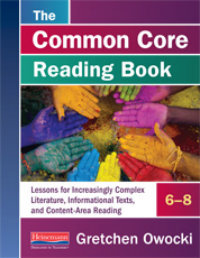Middle School Reading with the CCSS
The Common Core Reading Book, 6-8: Lessons for Increasingly Complex Literature, Informational Texts, and Content-Area Reading
By Gretchen Owocki
(Heinemann, 2014 – Learn more)

The Common Core Reading Book, 6-8: Lessons for Increasingly Complex Literature, Informational Texts, and Content-Area Reading is an excellent resource to support teaching and learning with the Common Core State Standards. SVSU professor Gretchen Owocki states that “effective teaching results from the skillful weaving of curriculum, carefully selected instructional practices, and thoughtful responses to students’ daily demonstrations of knowledge.” (p. xiv) I agree with her one hundred percent! And, in her book, she shows teachers how to weave these elements together to provide meaningful instruction.

- a single page description of each Anchor Standard with grade-specific competencies
- a page to help with instructional planning where Owocki poses the question “do my students need focused instruction in this reading anchor standard?”
- the instructional phases, which are to be used in sequence
o Demonstration
o Collaborative Engagement
o Independent Application
Demonstration
In this phase of the lesson, the teacher provides explicit instruction. The author includes a general lesson along with an “intensifying” lesson which supports differentiation. The author recommends teaching Anchor 1 (close reading) first as it supports the other standards. She also suggests that Anchor 9 (comparing and contrasting) be taught after some of the earlier lessons to prepare students for analyzing and comparing two texts.
The first step in this phase, Preparation, begins with text selection and identifying a focus. The teacher is actively engaged with students during the second part of the lesson, Procedures. The author suggests questions to address the grade-specific standards for both literature and informational texts. (See page 76 for example questions for Anchor Standard 4.) Graphic organizers and/or suggested texts are matched to these questions to help students reach the desired outcomes for each competency. (See page 52 for Anchor Standard 3 and pages 130 – 132 for Anchor Standard 6.) The third piece in Demonstration is the same for all Anchors: “Have a plan in place for students to explore the demonstrated processes in groups or independently.”
The author has produced an easy-to-follow lesson plan with common sense suggestions for introducing a concept, demonstrating that concept, and then supporting student exploration of the concept. Kudos to Owocki for the numerous graphic organizers; sadly, these are not available electronically.
Collaborative Engagement
Now, the teacher guides and facilitates students’ learning as they engage in reading, discussing, analyzing, comparing, contrasting or using whatever processes are required by the standard. The author provides prompts to support student-led group discussions. (See page 39 for Anchor Standard 2.) The teacher may need to provide extra support to small groups using ideas from Intensifying the Instruction at this point. (See page 112, Anchor Standard 5.) This portion of the lesson may conclude with whole-class discussion if everyone is reading the same text.
Independent Application
The expectation is that students have internalized the strategies and are discussing and/or writing, either independently or in small groups. Now the teacher steps back and becomes a master at eavesdropping; the goal is now to move about the room providing support as needed. A teacher may have a tough time deciding which activities to use; Owocki provides a varied range of paper/pencil and electronic activities.
The Common Core Reading Book, 6-8: Lessons for Increasingly Complex Literature, Informational Texts, and Content-Area Reading could also have an additional subtitle: The Book with the Intriguing Cover. While I am unsure of the significance of the cover art, I am sure that this is a book worth purchasing. Teachers who are feeling overwhelmed with the Common Core State Standards will be encouraged by this book.
Anne Anderson finally got out of the 8th grade after 24 years and 9 weeks. She spent the next 9 years sharing her expertise in literacy and writing with K-12 teachers and administrators throughout the district. She credits National Writing Project and Poetry Alive! as turning points in her growth as a teacher. She now shares her expertise nationwide as an educational consultant and through her website and her bi-monthly newsletter, Spotlight on Success.
Read a MiddleWeb review of Gretchen Owocki’s The Common Core Writing Book: Lessons for a Range of Tasks, Purposes, and Audiences here.




































